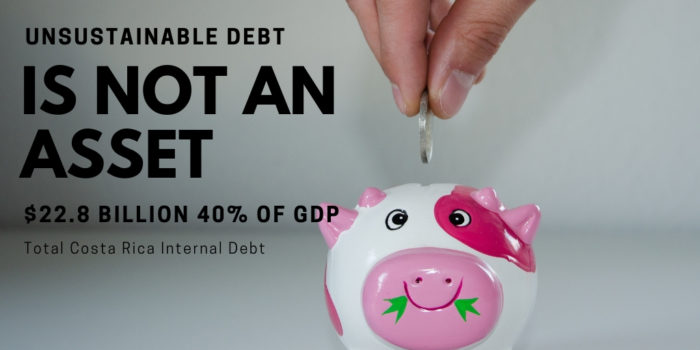
National attention in Costa Rica is overwhelming focused on the fiscal deficit and the recent strike by public workers. Politicians and bureaucrats are making comparisons to the economic and currency crash of 1980. However, the coming crisis has the potential to be much worse than in 1980, and the reasons have yet to be clearly articulated by the political leadership or the news media. Of the $28.3 billion in debt owed by the government, $22.8 (roughly 80 percent) is owed to domestic investors.
It’s difficult to know with any certainly who make up the national investors. But, given that the figure represents 40 percent of the annual GDP, the group likely includes the entire banking sector, public universities, along with the assets of autonomous government agencies and the pension funds of government works. Anywhere in Costa Rica where there are institutional assets to invest, it’s likely that a big chunk are invested in “low risk” government bonds, which pay a 4 to 5 percent annual return.
To service the debt, Costa Rica collects annually (2012 – 2017) between $6.5 and $8.3 billion in national revenue. According to the Vice Minister of Hacienda, Nogui Acosta next year the government will need to borrow an additional $9.16 billion. This year the government made $1.8 billion in interest payments. According to a report issued by Hacienda, government policy is to swap domestic debt with international debt because the interest rates are lower.
In other words, the government policy is continually borrow in order to pay current expenses and debt while spreading the risk of default from the domestic economy to international lenders. However, the plan isn’t working. This year as a percentage of GDP, external debt fell from 10.3 percent to 9.7 percent. In September of 2014, The Moody’s Rating Agency downgraded the sovereign debt of Costa Rica to junk bond status, effectively prohibiting reputable funds and institutional investors from loaning money to Costa Rica. Ratings fell further in 2016 and 2017 and earlier this month the ratings agency announced a further review.
A default now, with 40 GDP of the annual GDP invested in worthless government paper would be nothing short of tragic. Comparatively the U.S. housing bubble was 65 percent of GDP with $12.68 trillion at it’s peak in 2008. However, Costa Rica is not the United States and the colon is not an key world currency. Quantitative easing won’t be an option, and the $7 billion in treasury reserves won’t be nearly enough to save the currency, shore up the asset bubble and meet future government funding requirements.